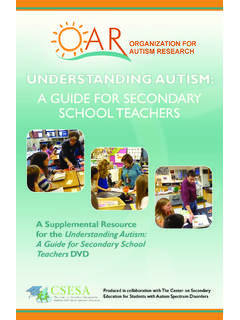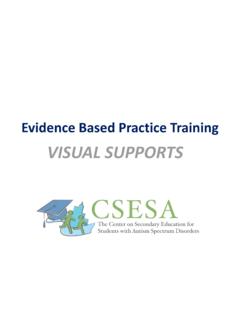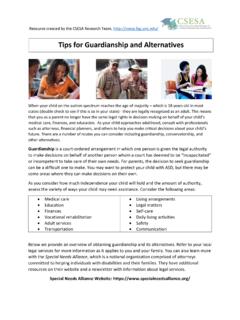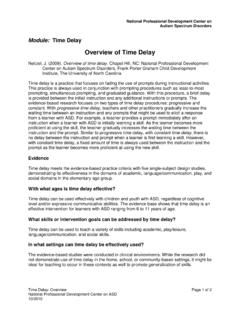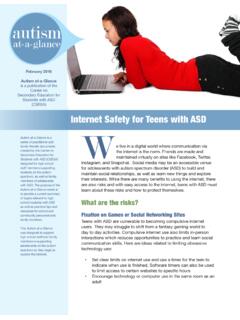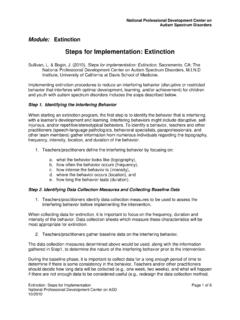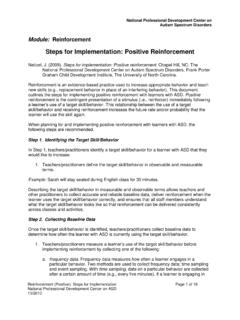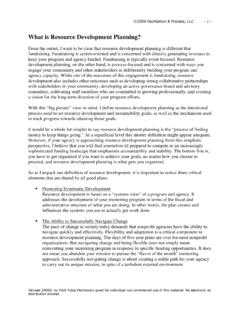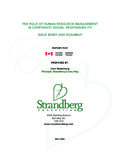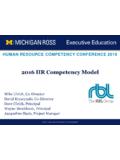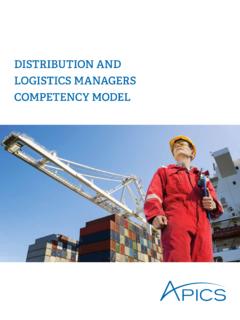Transcription of Community and School Resource Mapping - csesa.fpg.unc.edu
1 Community and School Resource Mapping (Module 1) 2 Table of Contents Overview of the Transition and Families Modules 3 Embedding Activities for Transition Skills in Standards-Based Instruction 5 Introduction to Community and School Resource Mapping : Module 1 6 CSESA Process 7 Transition Component Checklist 8 Community Resource Mapping Introduction 10 Possible Resource Mapping Team Members 11 Possible Community Resource Mapping Uses 11 Appendices List for Community Resource Mapping 12 School Resource Mapping Introduction 54 Possible School Resource Mapping Team Members 55 Possible Uses of School Resource Mapping 55
2 Appendices List for School Resource Mapping 56 Student Portfolio 71 3 Overview of the Transition and Families Modules The Center on Secondary Education for Students with Autism Spectrum Disorders (CSESA) Transition and Families (T & F) component is a critical component of the full CSESA model . Student-centered planning for a youth s future beyond high School that is built on input from the student, family, and various professionals familiar with the student is important to a young person with Autism Spectrum Disorder s (ASD) success in college (postsecondary learning), careers, and other adult living beyond high School . The T & F component includes five modules divided into the major topical areas (1) Community and School Mapping , (2) Transition Planning, (3) Student Involvement in the Individualized Education Program (IEP) planning and meeting, and (4) Work Based Learning Experiences (WBLE).
3 The fifth module, Transitioning Together for families and leaders of family groups, is another critical segment of the CSESA program and is located in a separate document. Within each module there is an overview of the expectations and process, followed by appendices of lesson plans, forms, and other instructional resources. At the end of each module there is a section including guidance for recording students progress through use of a Student Portfolio System. Additionally, there is a glossary of terms that may be used as a Resource which is located in a separate document. The process for the CSESA model on page 7 provides a context for how the various pieces of this T & F component fit within CSESA as a whole. The modules were developed as a blueprint for the teacher, case manager, or other School level professional implementing the curriculum.
4 However, its forms and tips may be useful for any of the stakeholders engaged with youth with ASD. Each of the modules includes: (a) an overview; (b) list of tasks to complete (page 8); (c) templates and forms for various activities, such as Community Mapping or Setting Up a School -Based Enterprise; and (d) guidance on permanent products to include in the Student Portfolio. The modules are provided electronically to allow teachers and other users to explore websites which may provide additional resources; however, the intent is not to send users of this curriculum searching for more information; but to provide the resources a teacher or team will 4 need to complete the curriculum. The additional links and resources are for teachers or schools who want to expand their transition program.
5 The Student Portfolio section in each module provides a list of products, by topical area, that may be selected to reflect a student s progress. There should be enough products included to get a sense of students strengths, interests, and accomplishments; but not so many that it becomes cumbersome. While students may need assistance in selecting the best or most representative samples from their work in this curriculum, student input and preference in selection should be valued. There are four possible methods for compiling the portfolio (a) an online portfolio system, (b) a School or district based shared drive, (c) a USB drive, or (d) a paper binder version. A task analysis is provided for each of the choices, which would be selected based on School and student factors.
6 Other permanent products from the academic and behavioral interventions in CSESA might also be documented in the Student Portfolio. The Portfolio may serve to not only track student progress in the CSESA Program, but as valuable transition planning information and contribute to the student s Summary of Performance documentation upon exit from high School . As noted, the Transitioning Together module is overviewed in a separate document along with the glossary. The guidance, scripts, forms, and tips for the family are contained in the fifth module. It is important, however, for professionals who are working with students through the T & F component of CSESA to be aware of the overall content, schedule, and structure of the Transitioning Together series.
7 Transitioning Together is a critical module of the T & F component, as family empowerment and engagement in transition planning are critical to successful outcomes for youth. How does this all fit together? The T & F component overlaps in time throughout implementation and informs the completion of each of the other components. For example, the Transition Services or Annual Goals in the IEP may relate to the completion of specific WBLE components, which may then inform future transition planning, based on a student s likes, dislikes, and accomplishments in that experience. Similarly, information gathered during the Transitioning Together classes may inform aspects of the Transition Planning process, as well. 5 A checklist for completing the transition component of the CSESA curriculum is included on page 8 of this module.
8 The Glossary may be useful as multiple stakeholders engage with this program. Embedding Activities for Transition Skills in Standards Based Instruction Post- School outcomes are the most important aspect of successful transitioning from high School to college and career fields. Because of poor post- School outcomes for students with ASD, there is a necessary requirement to engage students in activities that will expose them to college and career activities, ( Career Explorations, Job Shadowing, Work Sampling, Service Learning, Internships, Paid Employment, Apprenticeship, and/or Mentoring) and to provide opportunities for lessons in IEP participation and career research. Experiences should be selected that will support a student s postsecondary goals regarding college and careers.
9 For some students, they will participate in experiences that are more focused on employment, while others will participate in experiences directly related to college preparation. Participation in the activities should inform the transition assessment process and increase students skills, in preparation for their postsecondary goals. For students who have a postsecondary goal of attending a two- or four-year college, identifying time in the School day to complete a transition-related curriculum and/or work-based learning experiences in high School ( developing career awareness skills, participating in work experiences) and possibly completing a transition curriculum, such as Self-Directed IEP, may lead to greater success in postsecondary education (Test, Mazzotti, et al.)
10 , 2009). IEP teams composed of family members, School counselors, career technical educators, and,of course , the student may need to be creative in identifying ways to develop these important skills. Some high schools use advisory time or homeroom/home base as a period of time available each day, or at least one time each week, for all students to engage in some of the activities noted above. Participating in after- School clubs, establishing relationships with Community 6 mentors in the School , helping families complete certain activities with their child outside of School hours (possibly through the support of other families, agencies, or the School counselor) are other methods to gain additional knowledge about a variety of careers.
